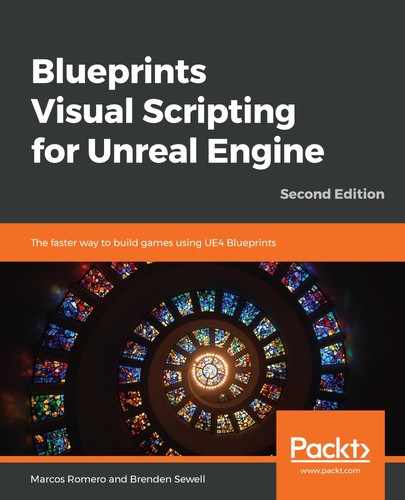In the Blueprint Editor, we are going to work with variables a lot, so let's start with the shortcuts related to variables. When you drag a variable from the My Blueprint panel and drop it in the Event Graph, a submenu appears for you to choose either the GET or SET node. But, there are shortcuts to create GET and SET nodes. If you hold the Ctrl key and drag a variable to the graph, then the Editor will create a GET node. To create a SET node, hold the Alt key and drag a variable to the graph. The following screenshot shows the GET and SET nodes:

There is another way to create GET and SET nodes. If you drag a variable and drop it on a compatible pin of another node, then the Editor will create a GET or SET node depending on the parameter type. The next screenshot shows an example of the Score variable being dropped on an input parameter pin. If the pin is compatible, then the Editor will show a tooltip with a check icon and a label such as Make B = Score. This expression means that the B pin of the node will get the value of the Score variable. So, the Editor will create a GET Score node:

If you drop the Score variable on an output parameter pin, as shown in the following screenshot, then the Editor will show the Make Score = ReturnValue label, and it will create a SET Score node using the ReturnValue label of the other node as the input parameter:

The Blueprint Editor has an automatic type conversion system. To use it, drag a wire from the pin of one variable type and drop it on a pin of another variable type. The next screenshot shows that a tooltip appears to confirm that the conversion is possible:

Another useful feature of the Blueprint Editor is that it is possible to change an existing node for another node that uses the same variable type without breaking the connections. There is an example of this in the next screenshot. Player Health and PlayerStamina are float variables. If you drag the PlayerStamina variable and drop it on the SET Player Health node, then the node will change to a SET PlayerStamina node and keep all connections:

There is a shortcut to create variables based on the type of an input or output pin of a node. To do this, right-click on a data pin and select the Promote to Variable option, as shown in the following screenshot. This option creates a variable and connects it to the pin:

If you need to break all the connections of a pin, then hold the Alt key and click on the pin. You can move all the connections of a pin to another compatible pin by holding the Ctrl key, dragging the connections, and dropping them on another pin. This is very useful because you don't need to redo the connections one by one. In the next screenshot, all the connections of the As First Person Character pin will be moved to the As Player Character pin:

The Blueprint Editor offers several options for node alignment. To use them, select some Blueprint nodes and right-click on one of them to open a menu. Alignment is one of the options of this menu. The following screenshot shows the Alignment options that are available:

Most of the Alignment options are self-explanatory, but let's look at an example: Straighten Connection(s). The next screenshot shows three nodes selected:

After applying Straighten Connection(s), the nodes will be organized, as shown in the following screenshot:

There are shortcut keys to create some common nodes in Blueprints. If you want to create a Branch node, then hold the B key and left-click on the graph. To create a Sequence node, hold the S key and left-click on the graph, as shown in the next screenshot:

Other shortcut keys are F + left-click, which creates a ForEachLoop node, and D + left-click, which creates a Delay node. These can be seen in the following screenshot:

To create a comment box around some nodes, first select the nodes, then right-click on one of the selected nodes and select the Create Comment option from Selection, or you can just press the C key. The next screenshot shows a comment box that is labeled More shortcut keys. Inside the comment box, there are more examples of shortcut keys used to create nodes:

When you get used to some shortcuts, you will see how they speed up your work. Now, let's look at tips to help you build better Blueprints.
